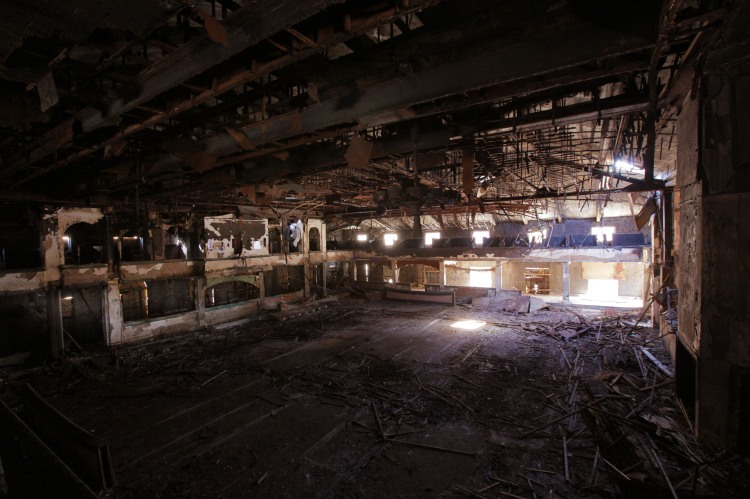AbandonedNYC
Abyssinian Development Corporation
The Harlem Renaissance Ballroom
The dance floor of the Harlem Renaissance Ballroom sprouts mushrooms today, but 80 years ago it quaked with the frenzied rhythms of the Lindy Hop.
The Ballroom was completed in 1924 as part of a larger entertainment hub that included a bustling casino and 900-seat theatre. Built and operated by black businessmen, the “Rennie” was the only upscale reception hall available to African Americans at the time. Prize fights, concerts, dance marathons, film screenings, and stage acts were held at the Renaissance, along with elegant parties and meetings of the most influential social clubs and political organizations in Harlem. The community’s elite gathered to dance the Charleston and the Black Bottom to live entertainment by the most renowned jazz musicians of the age.
The nightspot even played host to the nation’s first all-black professional basketball team, also called the Harlem Renaissance, considered by some to be the best in the world in their day. On game nights, portable hoops were erected on the dance floor, converting the ballroom into a stadium. Following each game, almost invariably a victory for the Rens, a dance was held where players would mingle and jive with the choicest ladies of Harlem. The team barnstormed in towns across the country, playing exhibition games in which coveted matches with white teams drew the largest crowds. In their best season, the Renns set a record with 88 consecutive wins that has yet to be broken.

View of the ballroom’s ruined interior from the bandstand.
A year before construction on the ballroom was completed, the institution that would one day demolish the Renaissance Casino moved in next door. The Abyssinian Baptist Church was once the largest Protestant congregation in the country, and continues to prosper today, both as a religious institution and a driving force of change in the surrounding neighborhood. Established in 1989, its nonprofit arm, the Abyssinian Development Corporation, has invested over $500 million in community development, becoming the most influential social service and housing provider in Harlem.
The corporation currently rents all of its 1,200 units of housing to low-income families, is responsible for constructing Harlem’s first new high school in 50 years, and has attracted numerous supermarkets, department stores, and national retail chains to aid in the development of the neighborhood. Despite their success, Abyssinian’s dealings have brought controversy in recent years. Many of their low-income tenants accuse the organization of neglect, pointing to hundreds of standing violations in their residential buildings. Their vision of the “New Harlem” seems at odds with some long-term community members, who call their “progress” gentrification.
The ADC purchased the Renaissance property in 1991 with plans to renovate the site back to its historical role as a social hall and community space. In the intervening years, they introduced a new plan that diverges sharply from their traditional housing ventures. While a portion of the property will be utilized as a community center, only 20% of the residential units will be “affordable,” the rest of the 19-story construction will be set aside for luxury condominiums. In a Times quote, Executive Director Sheena Wright cites the necessity of bringing “diverse income levels” to the neighborhood as justification for the project; she asserts, convincingly, that “one should not relegate Harlem to housing just for the poor.”
The first stage of development involves the demolition of the theatre structure. Plans call for the preservation of the ballroom’s facade, but the interior is coming down. The project almost hit a roadblock in 2006 when the structure was pegged for a Landmarks Commission review, but the ADC exerted its political muscle to block the designation, enlisting big name supporters like former Mayor Dave Dinkins, Manhattan Borough President Scott Stringer, and the New York Landmarks Conservancy to voice their opposition. In the five years that have passed since the ADC overcame this obstacle, a bleak economic climate has forced them to put the project on hold. Abyssinian is currently pursuing investors for the project.

A spotlight falls on the ballroom once again.
The site of the former theatre is now an empty lot harboring a few disused construction vehicles, but contrary to some reports, the Renaissance Ballroom still stands, for now.
Most of the windows are boarded up, but light finds its way through a caved-in ceiling, exposing the diaphanous remnants of a golden age—colored light bulbs still lodged in the nightclub’s chandeliers, seat numbers pinned in the balcony. Ghostly images of jazz singers and blasting trombones barely cling to the proscenium of the ballroom’s weathered stage, once graced by Duke Ellington, Count Basie, and Ella Fitzgerald. The sense of history here is palpable, and the deterioration absolute. Reduced to mulch, the dance floor supports a thriving green fungal colony. Little points to the existence of a casino on the lower floor, but a coatroom remains largely intact. The rest gives the impression of a war zone—feral cats tread freely over piles of rubble that once delineated rooms. It’s easy to see why Spike Lee used this location as a nightmare crack den in Jungle Fever.
Langston Hughes had the Rennie in mind when he described “a golden girl, in a golden gown, in a melody night, in Harlem town.” It’s been decades since the “mellow magic of dancing sound” has reverberated here, but the Ballroom remains significant through its connection to the cultural and intellectual movement it nurtured.

The floor of the ballroom was significantly decayed.

Can you spot the face beaming on these faded signs?

Box seats in the balcony of the Harlem Renaissance Ballroom.

Walls collapse in the downstairs lobby.

A dark hallway on the first floor.





